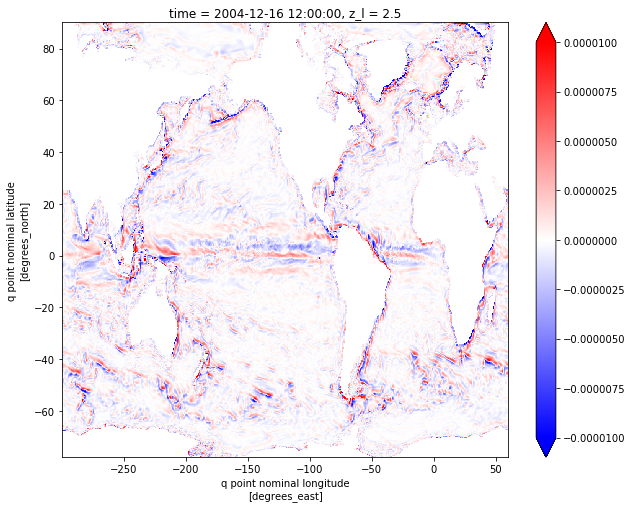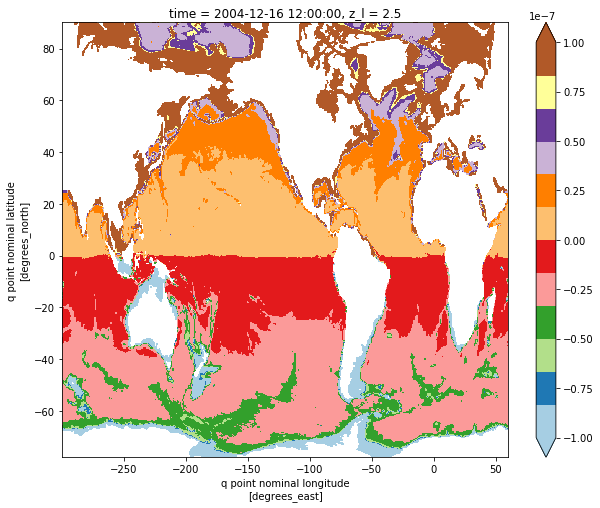Vorticity-based diagnostics
Vorticity is an omnipresent physical quantity in GFD. Here we show how to compute it from the model output:
[1]:
%matplotlib inline
[2]:
import xarray as xr
from xgcm import Grid
import numpy as np
[3]:
dataurl = 'http://35.188.34.63:8080/thredds/dodsC/OM4p5/'
ds = xr.open_dataset(f'{dataurl}/ocean_monthly_z.200301-200712.nc4',
chunks={'time':1, 'z_l': 1}, engine='pydap')
A quick look at the coordinates in the dataset shows that the grid is saved in non-symetric mode (see https://mom6.readthedocs.io/en/dev-gfdl/api/generated/pages/Horizontal_indexing.html for details) and that the first vorticity point is located northeast of the first center point, in agreement with the model’s conventions.
[4]:
ds
[4]:
<xarray.Dataset>
Dimensions: (nv: 2, time: 60, xh: 720, xq: 720, yh: 576, yq: 576, z_i: 36, z_l: 35)
Coordinates:
* nv (nv) float64 1.0 2.0
* xh (xh) float64 -299.8 -299.2 -298.8 -298.2 ... 58.75 59.25 59.75
* xq (xq) float64 -299.5 -299.0 -298.5 -298.0 ... 59.0 59.5 60.0
* yh (yh) float64 -77.91 -77.72 -77.54 -77.36 ... 89.47 89.68 89.89
* yq (yq) float64 -77.82 -77.63 -77.45 -77.26 ... 89.58 89.79 90.0
* z_i (z_i) float64 0.0 5.0 15.0 25.0 ... 5.75e+03 6.25e+03 6.75e+03
* z_l (z_l) float64 2.5 10.0 20.0 32.5 ... 5.5e+03 6e+03 6.5e+03
* time (time) object 2003-01-16 12:00:00 ... 2007-12-16 12:00:00
Data variables:
Coriolis (yq, xq) float32 dask.array<chunksize=(576, 720), meta=np.ndarray>
areacello (yh, xh) float32 dask.array<chunksize=(576, 720), meta=np.ndarray>
areacello_bu (yq, xq) float32 dask.array<chunksize=(576, 720), meta=np.ndarray>
areacello_cu (yh, xq) float32 dask.array<chunksize=(576, 720), meta=np.ndarray>
areacello_cv (yq, xh) float32 dask.array<chunksize=(576, 720), meta=np.ndarray>
deptho (yh, xh) float32 dask.array<chunksize=(576, 720), meta=np.ndarray>
dxCu (yh, xq) float32 dask.array<chunksize=(576, 720), meta=np.ndarray>
dxCv (yq, xh) float32 dask.array<chunksize=(576, 720), meta=np.ndarray>
dxt (yh, xh) float32 dask.array<chunksize=(576, 720), meta=np.ndarray>
dyCu (yh, xq) float32 dask.array<chunksize=(576, 720), meta=np.ndarray>
dyCv (yq, xh) float32 dask.array<chunksize=(576, 720), meta=np.ndarray>
dyt (yh, xh) float32 dask.array<chunksize=(576, 720), meta=np.ndarray>
geolat (yh, xh) float32 dask.array<chunksize=(576, 720), meta=np.ndarray>
geolat_c (yq, xq) float32 dask.array<chunksize=(576, 720), meta=np.ndarray>
geolat_u (yh, xq) float32 dask.array<chunksize=(576, 720), meta=np.ndarray>
geolat_v (yq, xh) float32 dask.array<chunksize=(576, 720), meta=np.ndarray>
geolon (yh, xh) float32 dask.array<chunksize=(576, 720), meta=np.ndarray>
geolon_c (yq, xq) float32 dask.array<chunksize=(576, 720), meta=np.ndarray>
geolon_u (yh, xq) float32 dask.array<chunksize=(576, 720), meta=np.ndarray>
geolon_v (yq, xh) float32 dask.array<chunksize=(576, 720), meta=np.ndarray>
hfgeou (yh, xh) float32 dask.array<chunksize=(576, 720), meta=np.ndarray>
sftof (yh, xh) float32 dask.array<chunksize=(576, 720), meta=np.ndarray>
thkcello (z_l, yh, xh) float32 dask.array<chunksize=(1, 576, 720), meta=np.ndarray>
wet (yh, xh) float32 dask.array<chunksize=(576, 720), meta=np.ndarray>
wet_c (yq, xq) float32 dask.array<chunksize=(576, 720), meta=np.ndarray>
wet_u (yh, xq) float32 dask.array<chunksize=(576, 720), meta=np.ndarray>
wet_v (yq, xh) float32 dask.array<chunksize=(576, 720), meta=np.ndarray>
average_DT (time) timedelta64[ns] dask.array<chunksize=(1,), meta=np.ndarray>
average_T1 (time) datetime64[ns] dask.array<chunksize=(1,), meta=np.ndarray>
average_T2 (time) datetime64[ns] dask.array<chunksize=(1,), meta=np.ndarray>
so (time, z_l, yh, xh) float32 dask.array<chunksize=(1, 1, 576, 720), meta=np.ndarray>
time_bnds (time, nv) timedelta64[ns] dask.array<chunksize=(1, 2), meta=np.ndarray>
thetao (time, z_l, yh, xh) float32 dask.array<chunksize=(1, 1, 576, 720), meta=np.ndarray>
umo (time, z_l, yh, xq) float32 dask.array<chunksize=(1, 1, 576, 720), meta=np.ndarray>
uo (time, z_l, yh, xq) float32 dask.array<chunksize=(1, 1, 576, 720), meta=np.ndarray>
vmo (time, z_l, yq, xh) float32 dask.array<chunksize=(1, 1, 576, 720), meta=np.ndarray>
vo (time, z_l, yq, xh) float32 dask.array<chunksize=(1, 1, 576, 720), meta=np.ndarray>
volcello (time, z_l, yh, xh) float32 dask.array<chunksize=(1, 1, 576, 720), meta=np.ndarray>
zos (time, yh, xh) float32 dask.array<chunksize=(1, 576, 720), meta=np.ndarray>
Attributes:
filename: ocean_monthly.200301-200712.zos.nc
title: OM4p5_IAF_BLING_CFC_abio_csf_mle200
associated_files: areacello: 20030101.ocean_static.nc
grid_type: regular
grid_tile: N/A
external_variables: areacello
DODS_EXTRA.Unlimited_Dimension: timeWe can then define our xgcm grid object (see https://xgcm.readthedocs.io/en/latest/ for details). Note that left/right is relative to the center point on a given axis, which means along Y up/down would translate to right/left. We also specify along which axes we need to apply periodic conditions.
[5]:
grid = Grid(ds, coords={'X': {'center': 'xh', 'right': 'xq'},
'Y': {'center': 'yh', 'right': 'yq'} }, periodic=['X'])
In symetric mode, we would define the grid object as:
grid = Grid(ds, coords={'X': {'inner': 'xh', 'outer': 'xq'},
'Y': {'inner': 'yh', 'outer': 'yq'} }, periodic=['X'])
Relative vorticity
The expression for relative vorticity (\(\zeta = \partial v / \partial x - \partial u / \partial y\)) on the irregular grid translates to:
[6]:
vorticity = ( - grid.diff(ds.uo * ds.dxCu, 'Y', boundary='fill')
+ grid.diff(ds.vo * ds.dyCv, 'X', boundary='fill') ) / ds.areacello_bu
Since the formula is evaluated lazily, it takes less than a second and since xgcm is aware of the labels, the resulting field has the right coordinates.
[7]:
vorticity
[7]:
<xarray.DataArray (time: 60, z_l: 35, yq: 576, xq: 720)> dask.array<truediv, shape=(60, 35, 576, 720), dtype=float32, chunksize=(1, 1, 575, 719), chunktype=numpy.ndarray> Coordinates: * time (time) object 2003-01-16 12:00:00 ... 2007-12-16 12:00:00 * z_l (z_l) float64 2.5 10.0 20.0 32.5 ... 5e+03 5.5e+03 6e+03 6.5e+03 * yq (yq) float64 -77.82 -77.63 -77.45 -77.26 ... 89.37 89.58 89.79 90.0 * xq (xq) float64 -299.5 -299.0 -298.5 -298.0 ... 58.5 59.0 59.5 60.0
We can look at surface values for the last time frame for a visual check:
[8]:
vort_plt = vorticity.sel(z_l=2.5, time='2004-12')
vort_plt.load() # so that we don't recompute each time we change the plot
[8]:
<xarray.DataArray (time: 1, yq: 576, xq: 720)>
array([[[nan, nan, nan, ..., nan, nan, nan],
[nan, nan, nan, ..., nan, nan, nan],
[nan, nan, nan, ..., nan, nan, nan],
...,
[nan, nan, nan, ..., nan, nan, nan],
[nan, nan, nan, ..., nan, nan, nan],
[nan, nan, nan, ..., nan, nan, nan]]], dtype=float32)
Coordinates:
* time (time) object 2004-12-16 12:00:00
z_l float64 2.5
* yq (yq) float64 -77.82 -77.63 -77.45 -77.26 ... 89.37 89.58 89.79 90.0
* xq (xq) float64 -299.5 -299.0 -298.5 -298.0 ... 58.5 59.0 59.5 60.0[9]:
vort_plt.plot(figsize=[10,8], cmap='bwr', vmin=-1e-5, vmax=1e-5)
[9]:
<matplotlib.collections.QuadMesh at 0x11aaa8668>

NB: This is plotted with the “nominal” longitude/latitude xq/yq. For true geographical coordinates, use geolon_c and geolat_c (grid corners).
Potential vorticity \((\zeta + f) / h\)
We need to interpolate deptho at the q-point (in 2 steps: first on U-point then on Q-point) and then this is pretty straightfoward:
[10]:
depthu = grid.interp(ds.deptho, 'X', boundary='fill')
depthq = grid.interp(depthu, 'Y', boundary='fill')
Note that the resulting array has now the same labels for coordinates than vorticity:
[11]:
depthq
[11]:
<xarray.DataArray 'mul-2e41182f53703b7dfb6668570b3584a4' (yq: 576, xq: 720)> dask.array<mul, shape=(576, 720), dtype=float32, chunksize=(575, 719), chunktype=numpy.ndarray> Coordinates: * yq (yq) float64 -77.82 -77.63 -77.45 -77.26 ... 89.37 89.58 89.79 90.0 * xq (xq) float64 -299.5 -299.0 -298.5 -298.0 ... 58.5 59.0 59.5 60.0
Consequently, xarray is going to recognize that arrays are co-located and perform operation:
[12]:
pv = (vorticity + ds.Coriolis) / depthq
[13]:
pv
[13]:
<xarray.DataArray (time: 60, z_l: 35, yq: 576, xq: 720)> dask.array<truediv, shape=(60, 35, 576, 720), dtype=float32, chunksize=(1, 1, 575, 719), chunktype=numpy.ndarray> Coordinates: * time (time) object 2003-01-16 12:00:00 ... 2007-12-16 12:00:00 * z_l (z_l) float64 2.5 10.0 20.0 32.5 ... 5e+03 5.5e+03 6e+03 6.5e+03 * yq (yq) float64 -77.82 -77.63 -77.45 -77.26 ... 89.37 89.58 89.79 90.0 * xq (xq) float64 -299.5 -299.0 -298.5 -298.0 ... 58.5 59.0 59.5 60.0
[14]:
pv_plt = pv.sel(z_l=2.5, time='2004-12')
pv_plt.load() # so that we don't recompute each time we change the plot
[14]:
<xarray.DataArray (time: 1, yq: 576, xq: 720)>
array([[[nan, nan, nan, ..., nan, nan, nan],
[nan, nan, nan, ..., nan, nan, nan],
[nan, nan, nan, ..., nan, nan, nan],
...,
[nan, nan, nan, ..., nan, nan, nan],
[nan, nan, nan, ..., nan, nan, nan],
[nan, nan, nan, ..., nan, nan, nan]]], dtype=float32)
Coordinates:
* time (time) object 2004-12-16 12:00:00
z_l float64 2.5
* yq (yq) float64 -77.82 -77.63 -77.45 -77.26 ... 89.37 89.58 89.79 90.0
* xq (xq) float64 -299.5 -299.0 -298.5 -298.0 ... 58.5 59.0 59.5 60.0[15]:
pv_plt.plot(figsize=[10,8], cmap='Paired', vmin=-1e-7, vmax=1e-7)
[15]:
<matplotlib.collections.QuadMesh at 0x11aa9c400>
